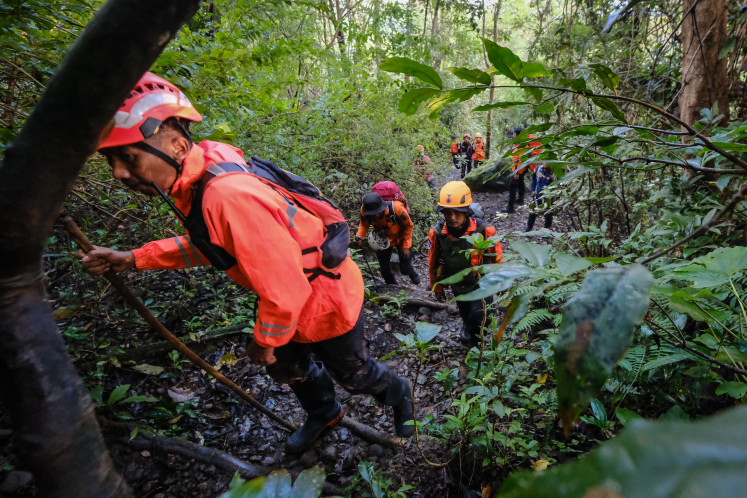Popular Reads
Top Results
Can't find what you're looking for?
View all search resultsPopular Reads
Top Results
Can't find what you're looking for?
View all search resultsHigh-yield seeds allow expansion without deforestation
Sowing the seeds: Workers tend oil palm seeds at an oil palm plantation in Kapuas Hulu, West Kalimantan
Change text size
Gift Premium Articles
to Anyone
Sowing the seeds: Workers tend oil palm seeds at an oil palm plantation in Kapuas Hulu, West Kalimantan. (Antara)
Indonesia's ambition to increase its crude palm oil (CPO) production from the current 27 million tons to 40 million tons by 2020 has raised concerns among international environmental NGOs that this would destroy more forests and, consequently, biodiversity and wildlife.
Deron Bangun, chairman of the Indonesian Palm Oil Producers Association (Gapki), refuted the claims, however, saying the expansion would not necessarily cause deforestation or the destruction of peatland.
'Planting high-yield oil palm seeds can increase production dramatically without requiring vast new plantations,' Bangun told The Jakarta Post in a recent interview.
Hence, he added, if the 10 certified oil palm seed producers, who have a combined annual capacity to produce over 200 million seeds, could develop new varieties with much higher yields than the current national average of 3.8 tons per hectare (ha), Indonesia would be able to double its output without opening new plantations.
Yields among small plantations is lower, varying from only 2 to 3 tons per ha. In Malaysia, the average yield is more than 4.5 tons per ha.
Deron, who is considered one of the most seasoned experts on palm oil, said he knew of several well-managed, large plantations in Sumatra that had seen yields reach 7 to 8 tons per ha.
Ang Boon Beng, chief researcher with palm oil conglomerate Asian Agri, concurred. 'Our Topaz seeds have even been known to produce up to 9 tons per ha in field trials four to five years after planting, depending on the soil conditions and plant management, Ang said.
Asian Agri's oil palm research station in Riau, which has an annual production capacity of 25 million seeds, is one of the country's 10 certified oil palm seed producers.
Ang added that several large commercial plantations in North Sumatra that had replanted with the new generation of Topaz hybrids had reported oil extraction of more than 25 percent, compared to the nationwide average of between 18 to 20 percent.
With higher-yield seeds, Ang explained, Indonesia could easily expand its production, while also conserving its forests and reducing poverty by producing higher incomes for growers.
Gapki executive director M. Fadhil Hasan, said he estimated the country needed more than 80 million oil palm seeds per year.
'This overall figure is based on an estimated plantation expansion of 200,000 ha along with the replanting of 120,000 ha a year,' he said.
He added that the combined capacity of the 10 certified oil palm seed producers was already more than enough to meet the demands of the industry.
'What is needed now are high-yield varieties,' Fadhil said.
Howard Sargeant, director of plantations with PT Samuel International, was optimistic about the prospect of further expanding palm oil production in Indonesia.
Oil palm seed research in Indonesia has been fairly advanced and Indonesia's soil was suitable for growing oil palms, said Sargeant, who has more than 40 years of experience in the palm oil industry in Malaysia and Indonesia.
Sergeant estimated that smallholders, who currently account for only about 40 percent of the 9.2 million ha of oil palm plantations in the country, would increase to 60 percent within the next five to 10 years.
There is another reason why Indonesia can significantly expand its palm oil industry without touching primary forests.
Research carried out in 2012 by the global environment and development think tank, the US-based World Resources Institute (WRI), highlighted the opportunities that were being missed to expand production on already deforested land in order to spare primary forests.
The WRI has published a methodology enabling the rapid identification of deforested land that could be suitable for the cultivation of sustainable palm oil.
WRI's research suggests that more than 14 million hectares of land in Kalimantan may be suitable for sustainable palm oil production.
The WRI report pointed out that, of course, not all 14 million ha should necessarily be turned into plantations; local people may not want particular tracts to be given over to palm oil. But, the WRI concluded, the scale of the potential was significant.
Experts, meanwhile, have predicted that the imagined expansion of 3 to 7 million ha of cultivated oil palms throughout Indonesia by 2020 could be met without clearing another hectare of forest or draining more peatland. (vin)










